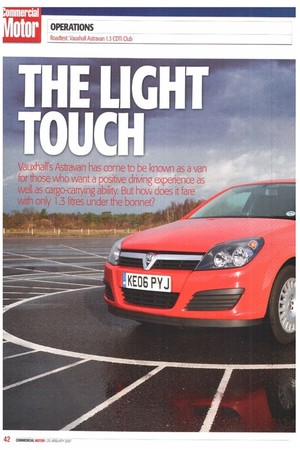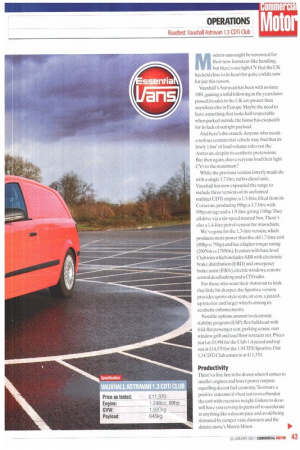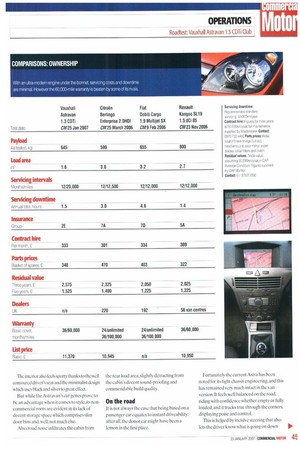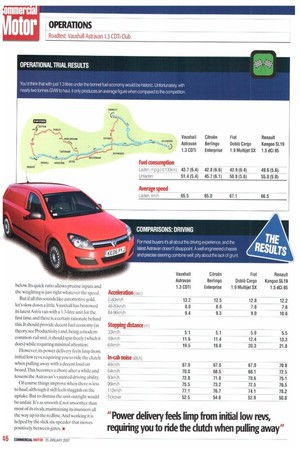Vauxhall's Astravan has come to be known as a van
Page 42

Page 43

Page 44

Page 45

Page 46

If you've noticed an error in this article please click here to report it so we can fix it.
for nose who want a positive driving experience as well as cargo-carrying ability. But how does it fare
with only 1 .3 litres under the bonnet? Modern vans might be renowned for their new-found car-like handling. but there's one hght CV that the UK has held close to its heart for quite a while now for just this reason.
Vauxhall's Astravan has been with us since 1981, gaining a solid following as the years have passed: its sales in the UK are greater than anywhere else in Europe. Maybe the need to have something that looks half respectable when parked outside the house has excused it for its lack of outright payload.
And here's the crunch. Anyone who needs a serious commercial vehicle may find that its lowly 1.6m of load volume rules out the Astravan, despite its aesthetic pretensions. But then again, does everyone load their light CVs to the maximum?
While the previous version latterly made do with a single 1.7-litre turbo-diesel unit, Vauxhall has now expanded the range to include three versions of its acclaimed multijet CDTi engine: a 1.3-litre, lifted from its Corsavan, producing 89hp:a 1.7-litre with 99hp on tap: and a 1.9-litre giving 118hp.They all drive via a six-speed manual box.There's also a 1.4-litre petrol version for masochists.
We've gone for the 1.3-litre version, which produces more power than the old 1.7-litre unit (89hp vs 79hp) and has a higher torque rating (200Nm vs 170Nm). It comes with base level Club trim which includes ABS with electronic brake distribution (EBD) and emergency brake assist (ERA), electric windows, remote central deadlocking and a CD/radio.
For those who want their Astravan to look that little bit sharper, the Sportive version provides sports-style seats, air-con, a j azzedup interior and larger wheels among its aesthetic enhancements.
Notable options amount to electronic stability program (ESP), flex bulkhead with fold-flat passenger seat, parking sensor, rear window grill and load floor restraint net.Prices start at £9,994 for the Club 1.4 petrol and top out at £14,570 for the 1.9 CDTi Sportive. Our 1.3 CDTi Club comes in at £1 1,370.
Productivity
There's a tine line to be drawn when it comes to smaller engines and lower power outputs equalling decent fuel economy.To ensure a positive outcome its best not to overburden the unit with excessive weight. Failure to do so will have you revving its pants off to accelerate at anything like a decent pace and avoid being skimmed by camper vans, dustcarts and the district nurse's Morris Minor. This scenario applies to the 1.3-litre version of the Astravan. and it's clearly to the detriment of its fuel economy — when fully laden it produced 43.7mpg, reflecting the strain it was under. Running unladen it managed 51.4mpg which much more in keeping with the 'frugal smaller engine' theory.
One element that has always counted against the Astravan is its load credentials. Being car derived,its priorities originally lay elsewhere. The good news is it is longer,taller and wider than the previous model. Vauxhall says this means more usable space, and payload is up 45kg to 645kg.
It certainly feels roomier in the rear than you'd expect for a vehicle with passenger car roots. Access is via the rear hatch where a high tailgate and low loading height make for easy loading though you do have to stretch to reach the front. Smaller packages can be reached from inside the cab over the standard half-height bulkhead.
For extra protection from sliding cargo there's a full-height half-mesh option —or spec Vauxhall's Flex bulkhead and fold-flat passenger seat that extends the load length from 1,825mm to 2,680rnm, Other standard features include six load restraint points and half-height plastic panelling to protect against moving loads.
Cab comfort
It won't come as any great surprise that the Astravan's interior resembles that of a car. but it's an attractively designed car.The driver is seated lower than in most similarsized light CVs and feels more integrated with the Vauxhall's controls.
The chunky steering wheel is good to grip and adjustable for rake and reach, while the instrumentation is clarity personified; the silver-effect edging on the dials adds emphasis. Also, the secondary controls such as heater and radio have a high-quality feel unmatched by many of the Astravan's rivals. The interior also feels sporty thanks to the well contoured driver's seat and the minimalist design which uses black and silver to great effect.
But while the Astravan's car genes prove to be an advantage when it comes to style, its noncommercial roots are evident in its lack of decent storage space which comprises slim door bins and. well, not much else.
Also, road noise infiltrates the cabin from the rear load area, slightly detracting from the cabin's decent sound-prOofing and commendable build quality.
On the road
It is not always the case that being based on a passenger car equates to instant driveability: after all, the donor car might have been a lemon in the first place. Fortunately the current Astra has been noted for its tight chassis engineering, and this has remained very much intact in the van version. It feels well balanced on the road, riding with confidence whether empty or fully loaded, and it tracks true through the corners, displaying poise and control.
This is helped by incisive steering that also lets the driver know what is going on down below. Its quick ratio allows precise inputs and the weighting is just right whatever the speed.
But if all this sounds like automotive gold, let's slow down a little. Vauxhall has bestowed its latest Astra van withal .3-litre unit for the first time, and there is a certain rationale behind this. It should provide decent fuel economy (in theory, see Productivity) and, being a modern common-rail unit,it should spin freely (which it does) while requiring minimal attention.
However, its power delivery feels limp from initial low revs, requiring you to ride the clutch when pulling away with a decent load on board.This becomes a chore after a while and lessens the Astravan's vaunted driving ability.
Of course things improve when there is less to haul, although it still feels sluggish on the uptake. But to dismiss the unit outright would be unfair. It's as smooth if not smoother than most of its rivals, maintaining its manners all the way up to the redline. And working it is helped by the slick six-speeder that moves positively between gates. •






















































































































































































